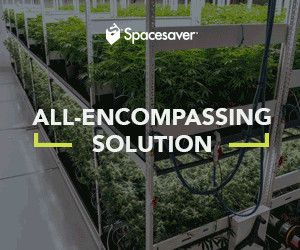How to Grow Indoor Cannabis
Cannabis cultivation is no longer only a hobby for personal enjoyment, it’s a full scale industry with a detailed supply chain. With the global legal cannabis market continually expanding, industrial-scale cannabis cultivation requires solid understanding of principles in both agriculture and business. Cultivating cannabis on a large scale requires thorough planning, technological insight, and adherence to legal regulations in order to produce healthy crops and turn a profit while making maximum use of the advantages of indoor growing techniques.
Know Your Grow
Like any good business strategist, you want to know your target market segment before you start building your infrastructure. When growing indoor cannabis that’s an especially important factor. Different strains of cannabis have different market appeal due to their varying effects and applications; these strains also grow differently, requiring strain-specific setups in lighting, nutrition, and climate control as well as slightly adjusted grow cycles. Some strains are popular with consumers, but less suitable for large-scale cultivation due to practical factors, like pest resistance and yield per plant. These factors can affect everything from the equipment you buy to the space you choose to house your operation, so you want to plan for them early on.
Choose Your Location
Choosing an appropriate location is a critical factor. Proximity to resources and logistical considerations play a significant role–remember, your space is now part of a supply chain. Many industrial growers choose former warehouse buildings, as they have lots of space and tend to be designed and located with shipping routes in mind.
Open spaces are ideal, and you’ll want to be able to customize the design for your operation and your staff. Crowded grow rooms mean clutter, and clutter means accidents that can harm staff and products alike. Consider a vertical growing system that can make maximum use of the high ceilings available in an industrial space, either on its own or combined with a mobilized storage system that can allow plant shelving to move along the floor in preset tracks, creating clear aisle-ways when needed and closing them to maximize grow space when not.
Have a Controlled Grow Environment
The main advantage to indoor growing is not being subject to the whims of the outdoors; you can grow strains suited to any climate, no matter where you’re located. You also don’t have to worry as much about the effects of weather fluctuations. You provide the light, air, and soil that allows plants to thrive, all in the confines of a controlled setting. This begins with the implementation of energy-efficient and high-performance lighting solutions. LED lights are a preferred choice due to their energy efficiency and longevity, complemented by High-Pressure Sodium (HPS) lights that excel during the flowering stage. To further precision, cultivators integrate automated lighting systems that guarantee exact control over light cycles and intensity–a factor that becomes especially important when precise control over lighting changes is essential to ensure optimal yield during flowering. Equally crucial is the management of climate within the facility. Automated control HVAC systems should be used to maintain temperature, humidity, and ventilation. The choice of growing medium also plays a significant role in creating a controlled environment. At an industrial scale, the decision between traditional soil cultivation and innovative hydroponic systems becomes strategic. Hydroponics, potentially augmented by aeroponics or drip irrigation systems, offer optimized space usage and efficient nutrient delivery, leading to expedited growth cycles. These systems can even incorporate automated nutrient management and irrigation to ensure that the plants receive consistent nourishment.
Streamline Harvesting and Processing
Harvesting indoor cannabis is a meticulous process that calls for careful planning and execution. Remember, the cultivation schedule of your strain or strain dictates the harvest time. Adopting a perpetual harvest approach can help keep the cultivation process in constant rotation, maintaining a consistent supply and quality without overwhelming resources and staff. Still, harvesting can be taxing on your infrastructure. Ensure you’re prepared for unexpected power outages with alternative power solutions, such as generators, to prevent spoilage during blackouts. Also plan ahead with streamlined protocols that prioritize cleanliness in harvesting and processing to prevent the spread of pathogens and pests in your facility.
In the last 1-2 weeks of the flower cycle, be sure to flush your plants–this gives them a better flavor profile. Examine trichomes on each strain closely to make sure they are ready for harvest; a digital microscope is best for this, but less expensive options like a standard magnifying glass can also work. When you’re sure they are ready to harvest, schedule your harvest day and time. You will want to do the harvest in the morning, when it’s still dark, and avoid turning on lights that can stress the plants, which will lead to harsh smoke.
Cure the buds properly in airtight containers, making sure to clearly label individual strands. Make sure you allow them to breathe regularly to prevent mold and ensure an even moisture distribution throughout the curing process.
Related Posts
- Maximize Space With Industrial Mobile Shelving ( April 17, 2024 )
- How to Make the Most of Compact Library Shelving ( April 17, 2024 )
- Hotel Housekeeping Storage Room Tips for a Seamless Operation ( March 14, 2024 )
- Unlocking Convenience: The Key Advantages of Personal Storage Lockers ( March 14, 2024 )
- Knowing Your Options for Hospital Storage Solutions ( March 6, 2024 )
- Military Gun Lockers: What Works Best ( March 6, 2024 )
- Practical Solutions for Medical Supplies Storage ( March 6, 2024 )
- How to Leverage Cannabis Vertical Grow Racks ( January 22, 2024 )
- 5 Ways to Organize Your Medical Office ( January 17, 2024 )
- 5 Healthcare Storage Solutions ( December 14, 2023 )



Leave a reply